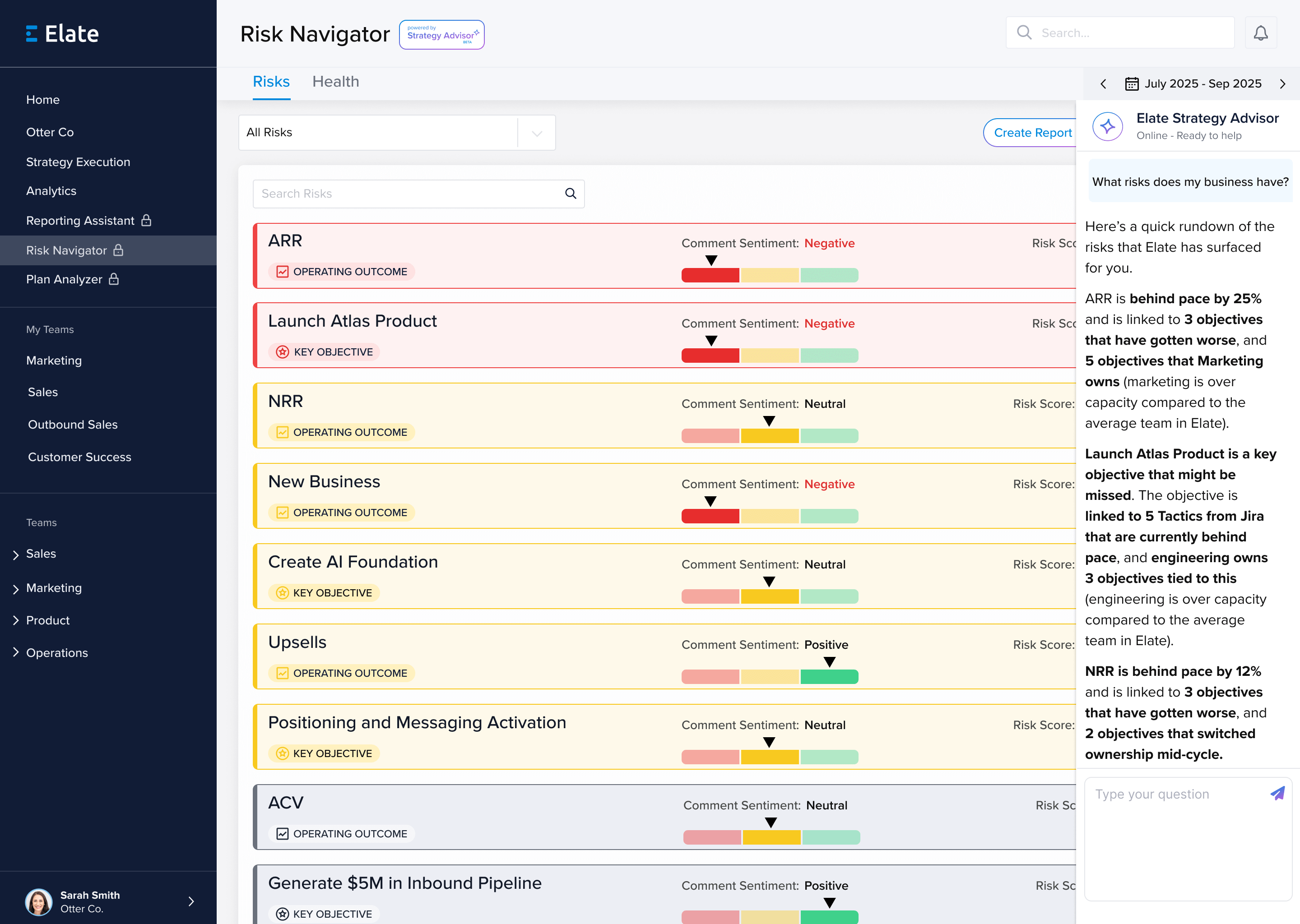One of the most important parts of rolling out an OKR Framework is establishing the cadence and structure for how you choose to execute your OKRs. Far too often companies get consumed by simply building their OKRs, and forget about what comes after the OKRs are created.
This lapse in establishing a clearly defined, structured process for reviewing OKRs often leads to the framework falling by the wayside and many employees wondering why the company spent so much time outlining the OKR meaning in the first place.
At Elate, we see it time and time again that companies spend countless hours trying to educate team members on OKR cycles, asking employees to read and study Measure What Matters performance reviews, or even hosting custom OKR training sessions. However, when the time comes to execute OKRs, they lose sight of the OKR review meaning and purpose.
For every company, there will come a point in your journey where it seems like OKRs or any goal-setting framework isn't working. If you don't have the proper OKR review meeting and cadence established, then it will almost certainly fail to take hold.
So for those strategy and operations leaders committed to building, executing, and evolving their operating framework, we wanted to highlight some of the OKR best practices we see across leading high growth companies.
How to Set OKRs
Let's start by quickly outlining how to set OKRs in a meaningful, impactful way for your company.
Start with Why: You've likely spent hours researching everything about OKRs and the OKR methodology. Everything from OKRs explained to the OKR acronym itself. But don't assume your employees understand why OKRs are the goal-setting framework you believe will help harness the momentum of your company and serve as a catalyst for growth. Explain why your company chose the OKR methodology and how you envision it helping your company continue to scale.
Establish a Clear Structure: Maybe the most important, but often overlooked part of setting OKRs is first setting a universal standard for what OKRs should represent at your company. Just as important as the 'why' behind the OKR process itself is the 'how' behind setting and measuring OKRs. By establishing a clear structure, you are providing employees with consistency and clarity in the process.
Align OKRs with Long-Term Vision: Too often the urge for strategy and operations leaders is to start building and executing against OKRs. However, employees should be able to align or associate their OKRs with company Themes or areas of focus. Whether or not you believe in a true cascading OKR structure is a company decision. However, every OKR should align with the long-term vision of success for the company.
Objectively Measure Performance: Last but not least, make sure every OKR being set has a measurable deliverable tied to performance. Now, don't misunderstand this point. Engineering isn't responsible for a measurable sales quota when they build a new product. However, they objectively should be able to justify whether the feature released or milestones delivered have been completed. Further, you as a company should be measuring the expected outcomes of that feature being built. Did we expect the feature to increase contract value? Increase customer stickiness or product uptime? Why did we choose to take on the objective, and how is it helping the business drive to success in a measurable way?
OKR Review Meeting Agenda
So now that we've established how we will be setting OKRs, we can transition into the OKR review meeting agenda. The OKR review meeting agenda should be designed to fit within your leadership or team meeting structure, and for many companies, the OKR review meeting agenda can actually help guide the entire meeting.
For many companies we work with, the OKR meeting structure provides a clean, intuitive step-by-step process:
1. Review the Status of Current Objectives. For many companies, the status is a green, yellow, red with each respectively representing on track, at risk, or behind. For those OKRs that are behind or at risk, the meeting owner could ask whether this is a topic of discussion that needs to be added to the agenda. If so, don't jump immediately into the issue. Instead, add it to your meeting agenda at the end. This allows all of the issues to be prioritized and discussed in order of importance.
2. Review Key Results and BAU's (Business as Usual metrics). Rather than looking at every single objective and the key results, make a scorecard that highlights the most pressing key results and other business metrics your team needs to be aware of at all times. Again, if there is a key result or metric that needs to be discussed, add it to the list of issues. Usually these issues are consolidated into issues with the overall OKR. Again, we are all about streamlining issues and discussions to be focused on the main priorities of the business.
3. Review Issues and Topics for the week. Finally, we can get to the part where we discuss the Issues and Topics facing our business for the week. Not only can these be added throughout the meeting, but they can also be added over the course of the week by any team members. However, it's important to prioritize all of the topics/issues in a way that focuses on the main priorities of the business. You might not get to every topic/issue, and that's alright. They can either move to the following week or if needed another meeting can be set up to specifically discuss those topics/issues.
4. Send an OKR Weekly Report. Now this is the cherry on top. Whether you'd like to tailor your OKR weekly report towards the leadership team or even build an OKR weekly report for all employees, it helps ensure there is constant alignment and focus on the priorities moving the business forward. For many leading companies, these reports can be automated with leading Strategic Planning solutions like Elate to help create consistency and save time.
So after four easy steps on how to run an OKR meeting, now we can shift to our OKR review template tailored towards helping team members accurately update OKRs and provide meaningful context.
OKR Review Template
The OKR review template is a great way to set proper expectations and a clear outline of what's needed from employees as they provide updates on the progress and performance of their OKRs.
From what we've seen, there are three critical updates needed to help ensure OKR examples are being properly updated and tracked. This helps ensure OKRs that were trending as on pace or green throughout the entire quarter don't suddenly fall off track or red in the last week of the time period.
First, provide the subjective update of on track, at risk, or behind. This can be done either directly in the Strategic Planning software you've implemented or through integrations into tools like Slack or Teams. With Elate, you can provide the status update in seconds after receiving a notification for your weekly OKR update.
Second, provide commentary on the overall performance of the objective. Why is it on pace, at risk, or behind. This subjective commentary can help provide context that saves additional hours spent digging into updates or trying to look at reporting on key results. Remember, the argument of OKR vs KPI doesn't have to be one or another. KPIs or often lagging indicators, but when used appropriately with context can turn into powerful insights for leadership.
Finally, automate the updates of key results and KPIs. Asking employees to update green, yellow, or red is one thing. However, asking them to update key results or KPIs in another solution when they are already likely doing it in the solution their department considers the source of truth is quite another. For many employees the manual part of OKRs can be burdensome and frustrating. If you haven't caught on yet, we believe in radically simplifying the process of asking employees to provide updates. Especially when it's duplicative work.
Today's Leading Software for Objectives and Key Results
So with an OKR framework built and the structure for your OKR review meeting in place, now your attention can turn to optimizing your company's Strategic Plan. Here at Elate, we think of Strategic Planning in three parts: Plan, Execute, and Review.
In order to make the most of your Strategic Plan and leverage your OKR framework as a catalyst for growth, it's important you have the right tools in place to maximize your OKR cycles.
With a traditional OKR performance management system, you are often limiting yourself to a simple OKR warehouse that will struggle to gain traction and adoption throughout your company. Rather than thinking of an OKR solution as just an OKR tracker for employees to provide updates, focus on how OKRs fit into your overall Strategic Planning process. At Elate, we provide the solution to help drive growth for today’s leading companies.
Elate is the leading Strategic Planning software built to help high growth companies communicate their vision, create alignment, and track performance all in one place.
If you'd like to learn more about how we are working with leading high growth companies as they continue to scale, don't hesitate to reach out to our team today! We'd love to share more on how we have partnered with other strategy and operations leaders to leverage OKRs as a goal-setting framework on their way to building great companies.











